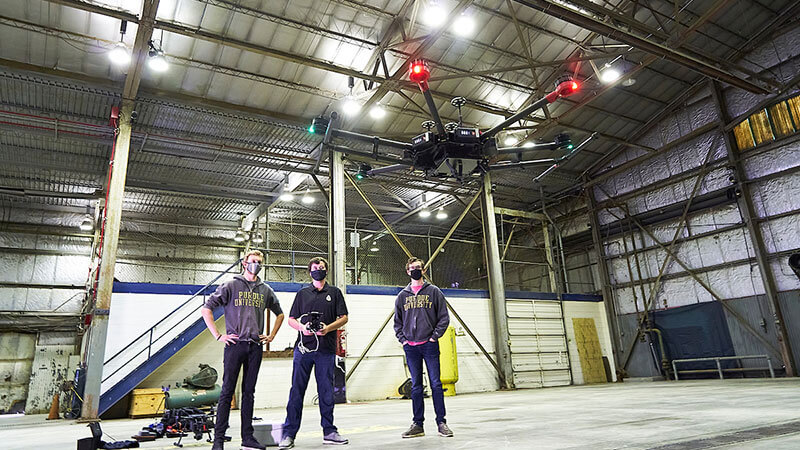Defense award launches Purdue project to strengthen cyber-physical systems

WEST LAFAYETTE, Ind. — Hiccups and failures of consumer cyber-physical systems like smart gadgets and appliances are inconvenient and annoying. But in mission-critical applications for the Department of Defense, any system weakness or flaw could have serious consequences, such as disruption, damage or even loss of life.
To help mitigate the problem, a group of Purdue University researchers has launched a multidisciplinary project to model, simulate and analyze cyber-physical systems (CPS), with the goal of rendering such systems more robust and making analysis of the systems more scalable and effective. Code named FIREFLY, the multiphase $6.5 million project is sponsored by the Defense Advanced Research Projects Agency (DARPA) under its FIRE program (Faithful Integrated Reverse-engineering and Exploitation).
“Cyber-physical systems are everywhere, with computing, control and communication capabilities increasingly equipped for today’s physical systems and infrastructures,” says Dongyan Xu, the Samuel Conte Professor of Computer Science and the principal investigator of the FIREFLY project. “We are honored to be part of DARPA’s FIRE program to improve our capability for CPS modeling, simulation and analysis.”
Xu is the director of CERIAS, Purdue’s Center for Education and Research in Information Assurance and Security, the nation’s first academic center for cybersecurity research and education. He also serves on the steering committee for the Purdue Institute for Physical Artificial Intelligence (IPAI).
FIREFLY will involve a variety of AI methods, such as machine learning, knowledge management and logic reasoning, to enable the modeling and analysis of CPS and any flaws or vulnerabilities found in them. FIREFLY also will leverage and integrate a wide, multidisciplinary range of knowledge and expertise including hardware and software analysis, complex system design, cyber-physical security and automatic control. FIREFLY will take advantage of Purdue’s state-of-the-art CPS experimentation test beds and facilities, such as the Purdue UAS Research and Test Facility.
Xu says that a technically intriguing aspect of the research is that, for a CPS with multiple cyber and physical components, the individual components may not appear faulty or vulnerable. But when the components start to interact, weaknesses or vulnerabilities may occur in unexpected ways: “When it comes to the security of system components and of the overall system, one-plus-one may be less than two. And we are particularly interested in exposing and analyzing such system-of-systems weaknesses.”
Ultimate success for FIREFLY, Xu says, will be a more rigorous and customizable methodology for CPS modeling, simulation and vulnerability analysis. FIREFLY methodology will help generate the cyber-physical systems’ models and simulators in a fast, scalable fashion. Xu adds that FIREFLY will also lead to new concepts and theories for U.S. scientists and engineers to study future systems with ever-increasing complexity, capability and intelligence.
“FIREFLY is both cutting-edge and timely in terms of the intentional integration of analytical models with simulation to drive learning,” says Dan DeLaurentis, vice president for Discovery Park District Institutes and the Bruce Reese Professor of Aeronautics and Astronautics. “It is also a great example of a premier center in our Institutes and Centers at Discovery Park District family, partnering with experts from our top-three aeronautics and astronautics engineering school. I look forward to the exciting results from this powerful team.”
The FIREFLY team consists of faculty members from multiple disciplines. Members from the School of Aeronautics and Astronautics are James Goppert, managing director of Purdue’s Unmanned Aircraft Systems Research and Test Facility and lecturer, and Inseok Hwang, professor of aeronautics and astronautics engineering. Three assistant professors of computer science participating are Antonio Bianchi, Z. Berkay Celik and Dave (Jing) Tian. Aravind Machiry, assistant professor of electrical and computer engineering, also is on the project team. Each team member is affiliated with CERIAS.
CERIAS has long been a leader in addressing security challenges in diverse cyber-physical domains, such as autonomous vehicles, critical infrastructures, smart environments and manufacturing. Every year, researchers and practitioners from academia, industry and government gather at the Purdue campus for the CERIAS annual security symposium, which defines and prioritizes current and future opportunities, challenges and threats in cyber and cyber-physical realms.
About Purdue University
Purdue University is a public research institution demonstrating excellence at scale. Ranked among top 10 public universities and with two colleges in the top four in the United States, Purdue discovers and disseminates knowledge with a quality and at a scale second to none. More than 105,000 students study at Purdue across modalities and locations, including nearly 50,000 in person on the West Lafayette campus. Committed to affordability and accessibility, Purdue’s main campus has frozen tuition 13 years in a row. See how Purdue never stops in the persistent pursuit of the next giant leap — including its first comprehensive urban campus in Indianapolis, the new Mitchell E. Daniels, Jr. School of Business, and Purdue Computes — at https://www.purdue.edu/president/strategic-initiatives.
Writer/Media contact: Amy Raley, araley@purdue.edu
Source: Dongyan Xu, dxu@purdue.edu